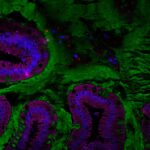Link to Pubmed [PMID] – 27672153
Link to HAL – inrae-02637409
Link to DOI – 10.1098/rstb.2015.0504
Philosophical Transactions of the Royal Society B: Biological Sciences, 2016, 371 (1707), pp.1-9. ⟨10.1098/rstb.2015.0504⟩
The intestinal microbiota is a large and diverse microbial community that inhabits the intestinal tract, containing about 100 trillion bacteria from 500-1000 distinct species that, collectively, provide multiple benefits to the host. The gut microbiota contributes to nutrient absorption and maturation of the immune system, and also plays a central role in protection of the host from enteric bacterial infection. On the other hand, many enteric pathogens have developed strategies in order to be able to outcompete the intestinal community, leading to infection and/or chronic diseases. This review will summarize findings describing the complex relationship occurring between the intestinal microbiota and enteric pathogens, as well as how future therapies can ultimately benefit from such discoveries. This article is part of the themed issue ‘The new bacteriology’.


